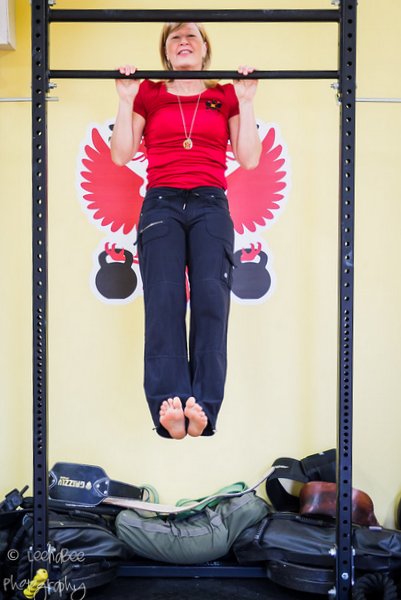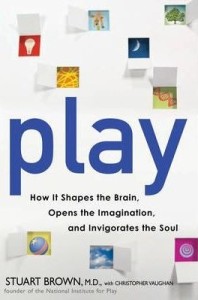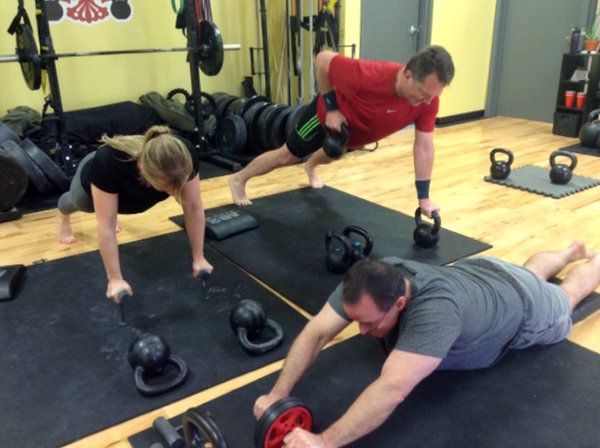
Fitness classes are social by nature and lend themselves to incorporating occasional play components to explore new, interesting and challenging movements and lifts with less structure, measurement or a set goal.
I call this Fitness Freedom.
The keys are:
1) Keep it exploratory
2) Give the student some control over how much they do and how they do it, and
3) Keep it safe.
Note: Play is not training riskier than usual; it is practicing relevant skills in creative ways when your students are ready for it.
 You can encourage creativity by using different fitness tools and combinations of movements that feel physically and mentally freeing, while still conditioning and challenging the body and the mind.
You can encourage creativity by using different fitness tools and combinations of movements that feel physically and mentally freeing, while still conditioning and challenging the body and the mind.
Stir the Imagination, Stimulate the Brain, and Reach into the Soul with Play
In Stuart Brown, M.D.’s book Play, he describes play “as important as diet and exercise to health.”
I agree.
So how do we incorporate play into our busy lives?
Our physical lives are the the perfect arena to explore play in a spirit of fitness freedom.
But we should already be thriving and enjoying our physical training–the everyday work should still feel fun.
Adding occasional play components can rev up our skill set in a new way and still be compatible with our current training methods.
For example, bottoms up kettlebell carries are challenging, but feel like play to me, and I like to find new ways to challenge myself with them. In the video below, I am balancing and moving mindfully with a kettlebell in the bottoms up position.
Often play starts out one way, and morphs into another way once our imagination kicks in.
Play is in the eye of the beholder and only limited by the imagination.
This opens the door to learning, creativity, improvisation and advanced skill development as individuals explore movements and lifts in a relaxed and exploratory environment.
I like to practice a climbing technique that I refer to as a jungle-up, and that often leads to practicing other hanging/pulling techniques on our suspended pullup bars. The jungle-ups condition the body for all types of bodyweight movements.
How Do Students Respond?
Some students enjoy the change … the freedom, the laughter, the ability to set their own limits and to try something new.
Others may tell you they prefer more structure with the reps, sets, and specific goals, but those are probably the students who will gain the most from fitness freedom.
How Often to Incorporate Play into Small Group Classes?
Play works well as an occasional warm-up component, a finisher, between sets, or as the main element of a lighter training day.
It can also be ideal for special occasion classes (holidays, open houses, family and friends events, special workshops, hump day, etc.)
You might decide to include a play component in Saturday classes when people are not rushing off to work and they have a more relaxed mindset. Or, you could add it as a recovery tool at the end of each round of a strength circuit
Play Examples for Small Group Kettlebell Classes
The Kettlebell Ameoba… often we are standing in one spot while we swing, clean, press, snatch, etc. Getting outside and moving as a group while we handle a kettlebell can feel playful while providing some great conditioning.
Sample Ameoba Programming with a Single Bell
(We use this is two teams, outdoors, and rest after each set of 10 paces.)
- Walking 2-arm kettlebell swings – 10 paces down and back
- 1-arm suitcase carry – 10 paces down and other arm back
- 1-arm racked kettlebell lunge – 10 paces down and other arm back
- Goblet hold and shuffle sideways – 10 paces down and back
- Your choice carry – 10 paces down and back
- Finish with single kettlebell figure-eight practice in the grass.
The Kettlebell Swing Wave… this idea came from Superb Health where we did it with a large group event. We used it when the Ohio State Buckeyes (our local team) were off to play for the national football championship. Our heavy 2-arm swing wave lasted as long as the Ohio State fight song and we started the swing as soon as the other person had the bell in the air–wave style.
Hand-Foot Crawling with Torso Stability Animals… the dog toys I keep in the gym for our occasional furry guests, come in handy when we are hand-foot crawling (great for warmup or as part of a circuit.) If the animal falls off a student’s back, add another animal and another to help them zero in on tightening their torso and moving the shoulders and hips.
Roxanne… playing the song Roxanne (or any song) and squatting (or any movement) every time you hear the word ‘Roxanne’. This is a great for warmup or a finisher–thanks to one of our gym members for this idea.
You-Go and I-Go Swings in Teams… two teams (one at a time) do 2-hand heavy swings in a 10-9-8 … 1 ladder (and maybe back up). We maintain active rest and cheer on the opposing team as they swing.
Kettlebell Figure-8s / Kettlebell Juggling… moving the bell in this way feels like play, but requires concentration, coordination and strength. Go light if you are new to this and make sure the flooring can handle an occasional dropped kettlebell — or better yet, head outdoors in the grass, to a volleyball sandpit or to the beach.
Push Exploration… set up an area with yoga blocks, Neuro-Grips, kettlebells for students to explore various push variations such as uneven push-ups, planks, kneeling fingertip push-ups, one-arm Neuro-Grip holds, ab wheel and so on. Not familiar with some of these? You might want to check out the PCC workshop. This is great fun. great conditioning and as a coach, you get visual feedback about your students’ strengths and weaknesses. We also use Pull Exploration with lots of hang and pull-up variations.

***
Lori Crock is an RKC Team Leader, PCC, MovNat-II and FMS-II strength and movement coach based in Dublin, Ohio (Columbus area.) She owns MoveStrong Kettlebells where she practices fitness freedom with her students who continue to amaze, inspire and educate her in small group classes. Lori can be reached at lori@movestrongkbs.com, www.movestrongkbs.com or on Facebook.